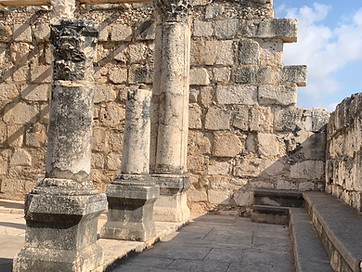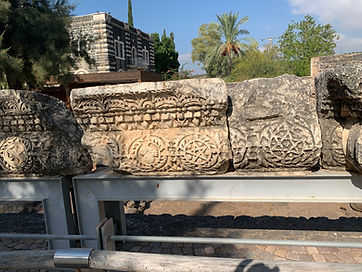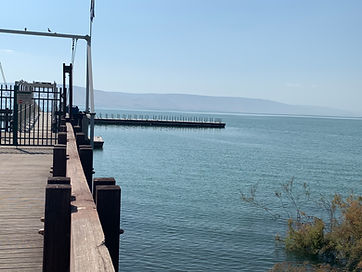The interesting ruins at Capernaum
Capernaum was a typical, prosperous Jewish town during Second Temple times and after destruction of the Temple. Among its ruins is an impressive partially reconstructed synagogue. At its base, are the ruins of the walls of a synagogue that could have been used by Jesus of Nazareth when he lived for a short time in Capernaum.
The Hebrew name for Capernaum is Kfar Nahum. This means village of comfort in Hebrew, but could also mean the village of Nahum. This village has no connection to the prophet Nachum. It was built in the Hasmonean period during the 2nd century BCE at the same time as a number of other Jewish villages were established around Lake Kinneret. It probably had no more than about 1,000 inhabitants.
After the destruction of the Second Temple, particularly in the late Roman period, the population of Kfar Nahum increased because of its location on the road between the Galilee and Damascus and because of its fishing industry and port. A large influx of Jews to the Galilee after the Bar Kochba Revolt added to its population. By the 4th century it had become a mixed Jewish and Christian town, although it was home to gentiles even by the 1st century CE. The town suffered from a number of major earthquakes, but was rebuilt after each of them. However, it was abandoned after a devastating earthquake in the 11th century.
Two other sites in this area are associated with Capernaum, namely Kfar Nahum National Park, which is located to the east of this site and is just outside the ancient town of Capernaum. It is administered by the Israel Nature and Parks Authority. It caters particularly to Christian tourists and offers boat rides on Lake Kinneret. Between this park and Capernaum is an area owned and excavated by the Greek Orthodox Church, and which contains their Church of the Holy Apostles. The Gospel Trail starts in Nazareth and ends at Capernaum.
The must-have guide for exploring in and around Jerusalem
"In and Around Jerusalem for Everyone - The Best Walks, Hikes and Outdoor Pools"
For FREE, speedy, home, courier service from Pomeranz Booksellers in Jerusalem click here (tel: 02-623 5559) and for Amazon click here. To view outstanding reviews click here.
VISITING CAPERNAUM
Directions and parking: Enter “Capernaum” into Waze and click on “Capernaum Synagogue.” Parking is available on the sides of the approach road. Alternatively, there is a parking lot on the right shortly after passing through the entrance gate.
Admission: Hours are 8.00 am to 5.00 pm. There is a small entrance fee collected by the Franciscan Church.
Public transport: There is an infrequent bus from Tiberias which stops close to the entrance to Capernaum. Enter "Capernaum Synagogue" into Moovit. Other bus lines stop at the Kfar Nahum Junction which is a 3.5 Km/43-minute walk.

The synagogues at Capernaum – when were they built?
The synagogue at Capernaum is one of the most impressive, if not the most impressive synagogue ruin in the Galilee. Capernaum was a prosperous community and its synagogue was built with white limestone blocks and pillars rather than the local basalt rock out of which their homes were made. The limestone was brought in from a distant quarry.
The synagogue is built on a platform. Flights of steps lead to the entrance façade, which has three doors facing Jerusalem. The prayer hall is rectangular with two rows of columns. There are stone benches along its eastern and western aisles. The paving is made of smooth limestone. Excavations revealed that the synagogue’s interior was richly decorated, being covered with painted plaster and stucco-work. The beautiful decorative work on the lintels, cornices and capitals can be seen from the displays by the side of the synagogue.
There has been considerable debate as to when this limestone synagogue was built. Its Italian excavators found 10,000 bronze coins sealed into the mortar of the floor, and this enabled them to date the synagogue to the late 4th to early 5th century Byzantine period. However, many Israeli archeologists disagree with this dating. They argue that an imposing synagogue like this would not have been built in Christian Palestine in the Byzantine period. It was not even permitted for Jews to build synagogues during this time. When they managed to skirt the law, the exteriors of their synagogues were subdued and decorative efforts were put into the interior of the building, particularly the mosaic floors. The synagogue at Hammath-Tiberias, only 10 miles away, is an example of this. Jewish symbols on the outside of the synagogue, such as a menorah, shofar and lulav, would have emphasized that they were flouting the emperors’ prohibition. Rather, this synagogue shows stylistic and artistic parallels to other synagogues in the Galilee and Golan built during the 2nd and 3rd centuries CE, which would be in the Roman period. How then can the bronze coins be explained? A suggestion is that they were placed here during a relaying of the floor in the 4th century.
Of note is that this synagogue was constructed on top of an older synagogue built of local (dark) volcanic stone, which has been dated to the 1st century CE. A wall section of this older synagogue can be clearly seen at the base of the later synagogue and was used as its foundations. This wall section is about three feet tall and was found beneath all four corners of the limestone synagogue.
It is quite possible that Jesus prayed and preached in this early synagogue. Capernaum was the base of his activities in the Galilee after he left his hometown hamlet of Nazareth and his second-cousin John the Baptist was killed (Matthew 4:13). He probably lived in Capernaum for 3 years until his death, which would have been in the 1st century CE. Jesus would finally curse this town, as well as Bethsaida and Chorazim, because of their lack of faith in him and their failure to repent.
Peter’s house has been identified and above it is a modern church.

The stone seating of the synagogue around its periphery dates from the 2nd or 3rd century CE.

Decorations on lintels and pillars from the synagogue. The Star of David was not a Jewish symbol at this time, and would not become so until the Middle Ages.

The Roman-period synagogue was built on an earlier 1st century synagogue of basalt stone, and this could well have been the synagogue in which Jesus of Nazareth preached.
Other nearby sites of Christian interest:
Kfar Nahum National Park. This national park is north-east of the Franciscan property. It has a pier and boats dock here from Ein Gev and Tiberias. It has restrooms, a gift shop, snack bar and restaurant. Directions: Enter “Kfar Nahum” into Waze and click on “Kfar Nahum National Park”. It is open Sunday to Thursday and Saturday in the summer from 8.00 a.m. to 5.00 p.m. and until 4.00 p.m. on Fridays and holiday eves. Closing time is 1 hour earlier in the winter. Their phone number is 04 679-3865. Click here for their website.
Church of the Holy Apostles:
The entrance to the Greek Orthodox site in Kfar Nahum is close to the entrance to Kfar Nahum National Park. Enter into Waze “Church of the Holy Apostles” and click on “Greek Orthodox Monastery Israel.”
Tabgha. This site on the lake is the traditional site of Jesus feeding 5,000 people and the miracle of the multiplication of the loaves and fishes. The Church of the Multiplication marks the spot and was recently constructed over the ruins of a 5th century chapel destroyed by the Persians in 614 CE. The Chapel of the Primacy commemorates the resurrection of Jesus. The name Tabgha is an Arabic mispronunciation of a Greek word for seven springs (Heptapagon), which is where Jesus fed the masses. Directions: Enter “Tabgha” into Waze. By the side of Tabgha is an area by the lake that many people use as a free beach.
Mount of Beatitudes (see the page The Mount of Beatitudes)
This is the traditional site of the Sermon on the Mount where Jesus spoke the beatitudes (blessings) (Matthew 5:1-12). The church was built by the Order of St Francis. Directions: Enter into Waze “Mount of Beatitudes.”
Bethsaida in the Jordan Park (see Family time in Jordan Park)
The Bethsaida Trail is one section of the Jordan Park. The first part of this trail is circular, is directed to Christian groups, and takes about 25 minutes. You can also do the entire trail which is about 2 Km and takes about 45 minutes. It is not circular and you will need to return to wherever your car or family is located.
The Yigal Allon Center at Ginosar (see also the page The Yigal Allon Center on this website)
On the ground floor of this museum is an ancient wooden boat. It was exposed in 1986 by the fall in water level of the Sea of Galilee, having been preserved by the clay around it. It has been dated from about 100 BCE to 100 CE. One of the reasons for the excitement about this boat is that this period includes the ministry of Jesus. This boat was found a bit south of Ginosar by the former town of Magdala. Many of the people that Jesus preached to would have been fishermen. Three of the disciples he recruited gave up their livelihoods as fishermen to join him - Peter, John and James - and this is the type of boat they would have used. Jesus would also preach from a boat to people on the shore. However, given the location of the wreck close to the town of Magdala it is most likely that this boat was sunk during the Battle of Migdal during the Great Revolt of the Jews against the Romans between 66-70 CE, which is after the time of Jesus. Many people were killed on Lake Kinneret during this battle. Directions: Enter “Yigal Allon Center” into Waze and click on “Yigal Allon Center, Ginosar.”
Magdala (see also the page Magdala on this website) :
Magdala is on the western shore of Lake Kinneret, 3 miles north of Tiberius, and is the presumed home of Mary Magdalene. Of considerable interest is the finding of the ruins of an ancient synagogue dated to between 50 BCE to 100 CE and thus likely before the destruction of the Second Temple in 70 CE.
Yardenit Jordan River Baptismal Site:
This is on the southern side of the Sea of Galilee by the River Jordan. Jesus was baptized by John the Baptist in the River Jordan (Matthew 3:13-17). This is an alternative baptismal site to El Yehud in the Jordan Valley close to Jericho. It contains 12 baptismal pools, a riverside promenade, gift shop, restaurant, WCs and showers. Entry is free. White robes can be rented or purchased. Enter into Waze “Yardenit Baptismal Site.” Their phone number is 04 675-9111. This is their Website.

The pier at Kfar Nahum National Park.
Links to the HOME PAGE and best family activities, hikes and historic sites in the GOLAN, EASTERN GALILEE, UPPER GALILEE, LOWER GALILEE, JORDAN VALLEY & LAKE KINNERET, the SHEFELAH, TEL AVIV-YAFFO and surroundings, NORTH of TEL AVIV, and SOUTH of TEL AVIV.
Do you find my website interesting and helpful?
Then you are sure to love my two new books "In and Around Jerusalem for Everyone - The Best Walks, Hikes and Outdoor Pools" and "The Struggle for Utopia - A History of Jewish, Christian and Islamic Messianism". Both books are available on Amazon and in Jerusalem bookstores. Click on each of the titles for information, reviews and purchase information.